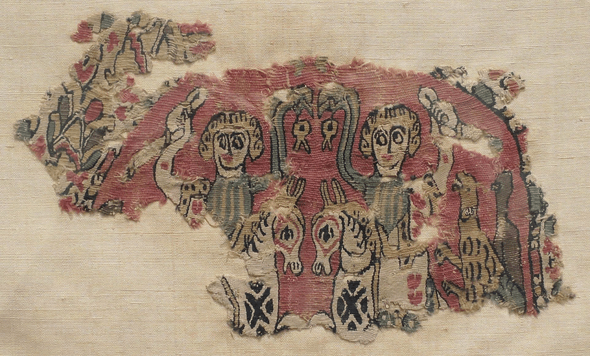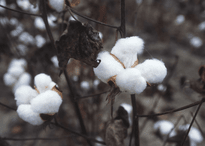Identifying Origin and Trade of Textiles using Strontium Isotopes
Archaeological textiles can provide important evidence of social traditions and status, the economics of textile exchange, and evolving weaving technologies.
 6th-7th century fragment of tapestry made of a wool and linen weave found in Egypt (Honolulu Museum of Art)
6th-7th century fragment of tapestry made of a wool and linen weave found in Egypt (Honolulu Museum of Art)
 Textiles are often made up of herbaceous and woody plant species, including cotton, linen silk and wool. These textiles can be tied to their origin using strontium isotopes, which are strongly bound to place based on the fact that geological units have specific 87Sr/86Sr signatures due to the geochemical make-up of the rock forming minerals. This signature is imprinted onto the above soil horizon as well as to the water, which is integrated into the overlying plants and eventually integrated into animals who consume the plants. As a result, the distinct isotopic signatures in geological units are transferred through the geosphere to the biosphere, connecting a plant or animal product to a specific area. Depending on the availability of data, there is potential for very detailed local scale mapped strontium ranges, which can pinpoint place quite accurately. Furthermore, the dating of textiles (via radiocarbon dating, 14C) can provide further information on chronology which may help narrow down potential origins.
Textiles are often made up of herbaceous and woody plant species, including cotton, linen silk and wool. These textiles can be tied to their origin using strontium isotopes, which are strongly bound to place based on the fact that geological units have specific 87Sr/86Sr signatures due to the geochemical make-up of the rock forming minerals. This signature is imprinted onto the above soil horizon as well as to the water, which is integrated into the overlying plants and eventually integrated into animals who consume the plants. As a result, the distinct isotopic signatures in geological units are transferred through the geosphere to the biosphere, connecting a plant or animal product to a specific area. Depending on the availability of data, there is potential for very detailed local scale mapped strontium ranges, which can pinpoint place quite accurately. Furthermore, the dating of textiles (via radiocarbon dating, 14C) can provide further information on chronology which may help narrow down potential origins.
Silk: a natural protein fiber produced from insect larvae fibroin used to form cocoons
Cotton: a soft stable fiber growing around the seeds of plants from the genus Gossypium (pictured right)
Linen: a strong, absorbent textile made from the fibers of flax (linseed) plants
Wool: animal fibers sheared from sheep, goats, rabbits, camelids and other mammals
In a recent study by Wozniak et al. (2022) analyzed late antique and medieval cotton and wool textiles (image, right) from south Sudan to identify origin and trade dynamics. A baseline for different region options was established by measuring the strontium isotopes of river sediments and underlying (Precambrian and Palaeozoic) rocks. The various regional baselines had overlapping isotopic ranges, making it difficult to unquestionably connect the textile to origin. Thus, additional evidence was required, including spinning direction and other weaving patterns as well as climatological and other environmental conditions required for plant growth.
In another study by Ryan et al. (2021), the researchers combined strontium isotopes and radiocarbon dating of cotton textiles and cotton seed samples from Arabia to reconstruct local vs. nonlocal sources. Based on this information, the authors established the earliest known use of imported cotton in the region, and eventual introduction of small scale local cotton production in desert oases.
It is important to note that textiles are also commonly dyed with natural materials including plants and vegetables, which can add noise to the provenancing of the underlying textile material if the dye was not sourced from the same region as the textile material. Frei et al. (2010) demonstrated a methodology to remove dye sources through an oxidative release as a pretreatment for strontium analyses. This process was undertaken by Frei et al. (2017) for the analyses of dyed pre-Columbian Andean textiles excavated from Pachacamac, Peru. The authors utilized a soil strontium isotope baseline map (Knudson et al. 2014) to interpret the 87Sr/86Sr results, finding a significant range of geographic origins with 90% of the textiles tested were nonlocal.
In order to analyze strontium isotopes, a small amount of dry textile is required (e.g. 100-150 mg of silk, cotton, and wool). For the best results, the samples should be clean and free from soil, clay particles, calcite, and other detritus. Since some of the textile samples are dyed with natural colors, the dye needs to be removed through the cleaning and pretreatment process. The Sr composition of the dye also can provide useful information about the local practices and trades.
Read more about Strontium Isotopes and accepted sample types.
Contact Isobar today to discuss using Strontium Isotopes to enhance your research!
References
Frei, K.M., Berghe, I.V., Frei, R., Mannering, U. and Lyngstrøm, H., 2010. Removal of natural organic dyes from wool–implications for ancient textile provenance studies. Journal of archaeological science, 37(9), pp.2136-2145.
Frei, K.M. and Bjerregaard, L., 2017. Provenance investigations of raw materials in pre-Columbian textiles from Pachacamac; strontium isotope analyses. In PreColumbian Textile Conference VII/Jornadas de Textiles PreColombinos VII (pp. 387-397). Nebraska: Zea Books.
Knudson, K.J., Tung, T.A., Nystrom, K.C., Price, T.D. and Fullagar, P.D., 2005. The origin of the Juch’uypampa Cave mummies: strontium isotope analysis of archaeological human remains from Bolivia. Journal of Archaeological Science, 32(6), pp.903-913.
Ryan, S.E., Dabrowski, V., Dapoigny, A., Gauthier, C., Douville, É., Tengberg, M., Kerfant, C., Mouton, M., Desormeau, X., Zazzo, A. and Bouchaud, C., 2021. Strontium isotope evidence for a trade network between southeastern Arabia and India during Antiquity. Scientific Reports, 11(1), p.303.
Wozniak, M.M. and Belka, Z., 2022. The Provenance of Ancient Cotton and Wool Textiles from Nubia: Insights from Technical Textile Analysis and Strontium Isotopes. Journal of African Archaeology, 20(2), pp.202-216.
Cotton Plant: https://en.wikipedia.org/wiki/Cotton#/media/File:CottonPlant.JPG
Textile image: Ryan, S.E., Dabrowski, V., Dapoigny, A., Gauthier, C., Douville, É., Tengberg, M., Kerfant, C., Mouton, M., Desormeau, X., Zazzo, A. and Bouchaud, C., 2021. Strontium isotope evidence for a trade network between southeastern Arabia and India during Antiquity. Scientific Reports, 11(1), p.303.
